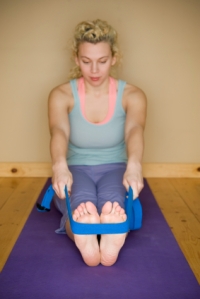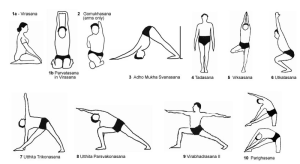Summary
A form of Hatha yoga, Iyengar is one of the oldest forms of yoga. A number of different props are used in Iyengar since emphasis is given to alignment and precision in every posture. Iyengar teaches how all eight aspects of Ashtanga yoga are integrated and focuses on the aspect of “sequencing,” the practice of intentionally grouping and linking specific asanas together.
Origins
Born in 1918, B.K.S. Iyengar began teaching yoga in 1936, after studying with the yoga guru Krishnamacharya in Mysore, India, in an effort to improve his health while suffering from tuberculosis. He continues to practice and teach today, assisted by his son Prashant and daughter Geeta, at his Ramamani Iyengar Memorial Yoga Institute in Pune, India. His methods are also taught at Iyengar institutes throughout the world, and at many yoga centers.
BKS Iyengar began his teaching in 1936 after studying in Mysore, India, with yoga guru Krisnamacharya. His pursuit started when he was attempting to improve his health while suffering from tuberculosis. Iyengar continues to practice today with help from his son Prashant and his daughter Geeta.
benefits
Aside from the basic benefits that any yoga practice gives us, Iyengar uses props that can benefit in a number of ways: they help with precision, put less stress on your muscles, and are helpful if you’re recovering from an injury.
Good for beginners?
Iyengar yoga is great for all levels, from advanced yogis who want to work on alignment or beginners who are getting used to the basic form of all postures.
What to wear
Try to steer away from loose clothing since alignment is a huge aspect of Iyengar yoga. Form-fitting clothing will help you and your instructor ensure you are practicing Iyengar safely and properly.

What to bring
Bring the yoga essentials: mat, water and towel. The props should be provided if you are a beginner – check with the studio you are practicing at.
What to expect
Iyengar yoga is popular both with beginners and experienced students. Expect a lot of attention to be put on alignment and how specific movements and sequences affect our bodies. Iyengar is a wonderful style for people looking to deepen their practice.
Asana:
In practice Iyengar yoga focuses particularly on three aspects. Correct body alignment allows the body to develop harmoniously in an anatomically correct way so that the student suffers no injury or pain when practising correctly. As all bodies are different and people have different weaknesses and strengths. Mr Iyengar has also developed the use of props to help the body into the correct positions required. Props are objects like wooden blocks, chairs, blankets and belts that help one adjust or support oneself in the different postures so that one can work in a range of motion that is safe and effective.
An added benefit is that although the therapeutic aspects of asanasand pranayama have been known for centuries, Mr Iyengar’s unrelenting emphasis on correct anatomical alignment and methods of working have refined the therapeutic aspects of Yoga. Thus practice of Iyengar yoga will often result in eliminating aches and pains, improve posture etc. but Iyengar Yoga can also be used to treat many ailments, including extremely serious medical conditions, under the supervision of a suitably experienced teacher. The other two key aspects of asanapractice in the Iyengar system are correct sequencing in which there is a powerful cumulative effect achieved by practicing asanas in particular sequences. The concept of timings means postures are held for considerable lengths of time to let the effects of the poses penetrate deeper within the individual

Pranayama :
Pranayama is started once a firm foundation in asana has been established as physically the student requires the alignment, flexibility, lung capacity and training necessary to sit and breathe correctly while practicing. Pranayama gives numerous physical benefits including toning the circulatory, digestive, nervous and respiratory systems, activating the internal organs and creating a feeling of energy and calmness. Equally importantly it also brings the mind and senses under control and make the individual fit for the experience of meditation.
Meditation:
As indicated, meditation is a state of mind that cannot be learnt and thus the practice of sitting and attempting to meditate is not a guarantee of results in itself. Rather the foundations of self culture have to be built through practicing the first five disciplines of yoga. The experience of meditation comes when the student is ready.
This leads to another keynote of Iyengar yoga: meditation in action. If one can meditate on a flame, grain of rice or other subject, why not meditate on the posture one is performing? So, as a student does yoga postures the mind learns to become aware of the different parts of the body. At first the mind moves from part to part but with training learns to become absorbed in all parts of the body evenly at the same time. One learns to refine one’s awareness and penetrate deeper into the body in order to achieve more accurate and thus effective and comfortable postures. So the mind is trained to achieve a meditative state of being. Although pranayama is the real key to preparation for meditation, the progress made is applicable toasanas which can be practiced to such a degree of refinement that one meditates in the posture.

What distinguishes Iyengar Yoga from other styles of yoga
In summary, the Iyengar method of Yoga may be said to define itself as different from other styles of Yoga by 3 key elements, namely technique, sequence and timing:
Technique means that in practice one learns ever finer adjustments in the alignment of how one performs one’s asana and pranayama.Sequence refers to the sequences in which asana and pranayama are practiced. For example, by varying which postures are practiced after which, the mental and emotional effects of the practice can be intensified in a manner not otherwise possible in order to bring about changes to the whole being including ones spiritual evolution. Timingrefers to the length of time spent in postures or pranayama. Postures cannot be done swiftly or without awareness. It takes time to move into a posture and become stable. When this has been achieved then one remains stably for some time to intensify the depth of the posture and so extract its benefit. Otherwise the potential effects and benefits remain small compared to what is possible.
So one can begin to see how Iyengar yoga cultivates all 8 disciplines of yoga and is far from merely “gymnastics and deep breathing.” With practice and understanding, one realises that Asana (posture) is as different from stretching or gymnastics just as Pranayama (Breath control) is different from merely deep breathing and meditation is different from self-induced trance.
The prolonged practice of asana and pranayama affects the individual on an organic (physiological), mental and spiritually level as well as just physically.

For more info on Iyengar: http://www.bksiyengar.com/modules/Iyoga/iyoga.htm


Thanks in support of sharing such a nice thinking, article is good, thats why i have read it completely
Its like you read my mind! You seem to grasp a lot about this, like you wrote
the e book in it or something. I feel that you could do with some
p.c. to drive the message home a bit, but instead of that, this is fantastic blog.
An excellent read. I’ll certainly be back.